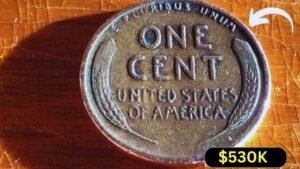Imagine digging through your pocket and discovering a single penny worth enough to buy a luxury car. That’s the thrill surrounding the Lincoln Wheat Penny—especially rare versions valued at $49,000 or more. While most are worth just one cent, a handful of these historic coins could still be circulating today. Let’s uncover the facts, spot the treasures, and see if you’re sitting on a fortune.
History of the Lincoln Wheat Penny
Minted from 1909 to 1958, the Lincoln Wheat Penny marked a milestone as the first U.S. coin featuring a president’s portrait. Victor David Brenner’s design showcased Abraham Lincoln on the front and wheat stalks on the back, symbolizing prosperity.
- Key Era: Replaced in 1959 by the Lincoln Memorial penny.
- Total Minted: Billions, but rare variants stand out due to errors and low production.
These pennies capture America’s early 20th-century story, making them a collector favorite.
What Drives a Wheat Penny’s Sky-High Value?
Value spikes from scarcity, condition, and mistakes. A typical circulated Wheat Penny fetches 3–10 cents, but rarities command thousands.
Top Factors for $49,000+ Prices
- Minting Errors: Doubled dies or wrong metal (e.g., 1943 copper instead of steel).
- Low Mintage Years: Fewer coins produced mean higher demand.
- Mint Marks: “S” (San Francisco) or “D” (Denver) often signal rarity.
- Condition Grading: Mint State (MS) 65+ grades multiply value 10x or more.
| Rare Example | Key Feature | Recent Auction Value |
|---|---|---|
| 1943 Copper | WWII error (should be steel) | Up to $204,000 |
| 1909-S VDB | Low mintage + designer initials | $100,000+ in top grade |
| 1955 Doubled Die | Visible doubling on date/letters | $1,000–$50,000 |
A verified 1943 copper penny in pristine condition recently hit $49,000—proving the potential.
Can You Still Find One in Circulation?
Yes, but odds are slim. Billions entered circulation, and many rare ones lurk in old jars or rolls from banks.
- Real Finds: People have discovered 1943 coppers in change or inherited collections.
- Reality Check: Most valuables are already in collections; new discoveries are rare.
Quick Tip: Search coin rolls from your bank—focus on pre-1959 dates.
How to Identify a Valuable Wheat Penny
Grab a magnifying glass and check these hotspots:
- Date: Prioritize 1909, 1914, 1922, 1931, 1943, 1944, 1955.
- Mint Mark: Below the date—“S” or “D” boosts value.
- Errors: Look for doubled text, off-center strikes, or bronze in 1943.
- Condition: No wear, original luster = higher grade.
Never clean coins—harsh methods scratch surfaces and slash value by 50% or more. Get suspicious finds appraised by PCGS or NGC.
Why Collectors Chase Wheat Pennies
Affordable entry (common dates under $1) plus jackpot potential keep the hobby alive. Build a full 1909–1958 set for under $200, then hunt keys.
FAQs
What makes a Lincoln Wheat Penny worth $49,000?
Rare errors like the 1943 copper or top-graded keys from low-mintage years.
Are valuable Wheat Pennies still in circulation?
Possible but unlikely—check old jars, bank rolls, or family heirlooms.
How do I check my penny’s value?
Note date, mint mark, and errors; use a loupe, then consult a professional grader.
Is the 1943 copper penny authentic?
Yes, about 20 exist from a mint mistake; fakes abound, so authenticate.
Should I clean an old Wheat Penny?
No—cleaning damages patina and can cut value in half.
Start Your Treasure Hunt Today
Your next coffee change could hold history worth thousands. Sort those pennies, learn the key dates, and join the millions enchanted by Wheat Penny lore. Who knows—$49,000 might be one flip away. Grab a loupe, hit the bank for rolls, and turn spare change into serious cash. Happy hunting!




